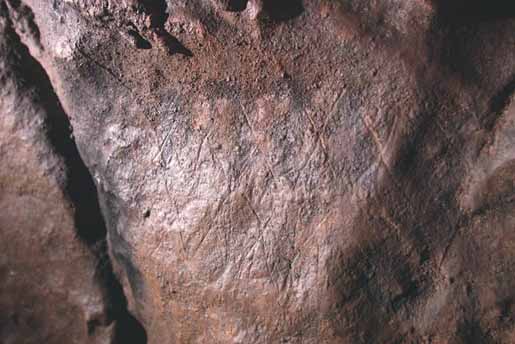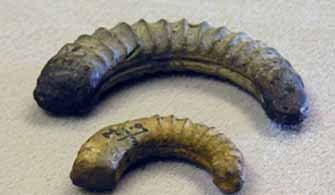

The talk focused on the material culture from the Mendip caves that suggests complexity in Prehistoric Societies. It looked at how everyday activities can be inter-twined with ritual activities. It looked at rock art and how it is interpreted. Two caves were discussed – Aveline’s Hole (Burrington Coombe) and Gough’s Cave (Cheddar Gorge). Aveline’s Hole was discovered in 1797 when two boys chasing a rabbit discovered upwards of 100 skeletons at the mouth of the cave “lying promiscuously, almost converted to stone”. The Rev. Skinner visited the cave twenty two years later and drew a sketch from the personal memories of those who had seen the discoveries. Boyd Dawkins excavated in 1865 and the University of Bristol Spelaeological Society dug inside the cave in 1914, 1919 and 1924. They found skulls and thin hearths. There are publications in the 1920s by J.A. Davies and Prof. Tratman and more recently by Rick Schulting. Unfortunately, many of the finds that were housed in Bristol Museum were destroyed when it was bombed in WWII.
The cave has two phases of activity: as an Upper Palaeolithic hunting camp and as a burial cave in the Mesolithic. Flint, animal bone and human remains have been recovered together with some unusual finds. There is a small barbed point of red deer antler found above the jaws of a brown bear; 16 perforated periwinkle shells (Littorina obtusata) probably strung as a necklace; a Carboniferous gastropod; “a nest of seven Ammonite body cases” as described by Davies in 1925 (see U.B.S.S. Proceedings on-line www.ubss.org.uk). What were seashells doing in a cave many miles from their source? Did they form an essential part of the burial rites? Did hunter-gatherers bring the shells from the coast to remind them of their ancestry?
The ammonites had been deliberately modified to produce semi-circular segments of whorls and not whole ammonites. The ends are worn and they may have been used as tools, or they may have been regarded as having magical properties and were used as such during the burial ceremony.

In the furthest recesses of the cave there are engraved crosses on the rock face – rock art! It was discovered in 2004 by UBSS cavers Graham Mullan, Linda Wilson and Tony Boycott. There is no scientific dating for the rock art, but analogies from Scandinavia places it with geometric designs found on bone and amber, to the Mesolithic. How closely was the art linked with the burials and why is it in such a dark and inaccessible place? In the Mesolithic the cave should be regarded as a special place for burial that was frequently used in the late Mesolithic, after which it was sealed for good. Art, ritual and burial are inextricably linked and this may have formed an important part of social organisation.
Gough’s Cave in Cheddar Gorge has an interesting and varied history from as early as the late 1980s when the Gough family opened up and extended the cave to allow admittance to the paying public. In 1892 a “large quantity of bones and teeth of extinct animals, besides a lot of flint knives and bone instruments” (Wells Journal 1892) were discovered. In 1903 ‘Cheddar Man’ was found during excavation to combat flooding. In the 1920s R.F. Parry recorded over 7000 flint tools, human and animal bone, ivory and antler (including the second bâton of reindeer antler and the pointed incised hare tibia). The flint is Magdalenian (Creswellian) and belongs to the Late Upper Palaeolithic. In 1986 when a drain was being dug at the entrance of the cave, both human and animal bone, together with flint tools were retrieved. This resulted in an excavation directed by the Natural History Museum, which included Chris Stringer, Roger Jacobi and Andy Currant. Both human and animal bone had cut marks and is dated to 12,400 – 11,800BP (Late Upper Palaeolithic). The animal bone is mixed with the human bone.
What is unusual and interesting about Gough’s Cave at this time, is the presence of carefully modified skulls into cups. Although this prompted a media excitement of ‘cannibalism in Cheddar’, it was not until careful scientific analysis in 2011 confirmed that not only were skulls being carefully modified into cups, but body processing had taken place, probably for human consumption, prior to the skull cup processing. Both adults and children are represented in the 37 skull fragments in the collection and are 1 young child (3 years), 2 adolescents, 1 adult and 1 elderly adult. The skull cups are dated to 14,700BP, which makes them the oldest skull cups in Europe. There are many European examples of modified skulls, most notably from the cave of Le Placard, in the Charente, France, where 24 individuals had had their skulls worked into containers. At the cave of Maszchka, S. Poland, 16 skulls have evidence of scalping, cutting, scraping, biting on crania that were scattered outside the cave. These are just two examples of what was a fairly common practice in Europe in the Upper Palaeolithic. The Gough’s Cave skulls are the only evidence we have of this practice in the country.
The processing of the bodies had been carried out skilfully and deliberately and flesh and tissue had been carefully removed with flint tools for consumption, prior to meticulous shaping of the skulls. Analysis of the bone has shown that the skulls were formed using a percussion process to obtain the shape required. No animal skulls were found to be modified. The analysis can be found on-line at Bello, S.M., Parfitt, S.A. and Stringer, C.B., 2011. ‘Earliest Directly-Dated Skull Cups’, PLoSONE, 6(2).
Many questions can be asked of this practice: did the skulls belong to the same family group? Did they all die at the same time? Were the bodies processed as part of a sacrificial practice? Were they trophies? Was the practice an integral part of their social organisation? Gough’s Cave was used primarily for hunting wild horse in the Upper Palaeolithic, but this latest evidence suggests that ritual and everyday activities were closely inter-twined.
The Mendip caves had been chosen as special places both for ritual and art. Aveline’s Hole was a place for burial, remembrance and art in a dark and inaccessible place. At Gough’s Cave there is complex ritual activity inter-twined with hunting activities. The combination of cannibalism and skull-cup production is unique in the European Upper Palaeolithic. The date of 14,700 cal BP make these the oldest dated examples of skull-cups in the archaeological record.
